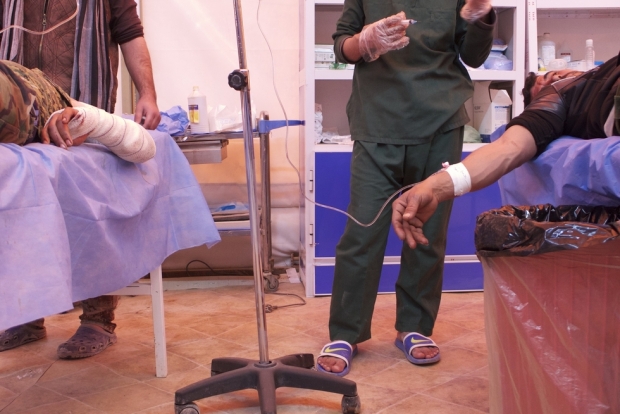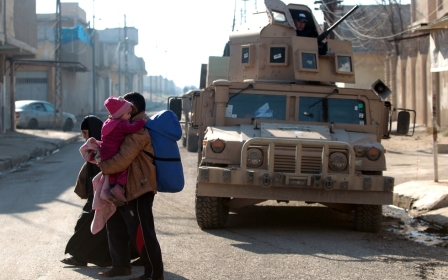'We will never give up': Iraqi troops battle to cut IS escape to Syria

EIN AL-HASSAN, Iraq - The hilltop dugout overlooking a strip of desert stretching towards the the Syrian border is piled with mortar and artillery shell casings, empty ammunition boxes, and even ration cartons.
The kilometre and a half of no-man's land between the dugout and the desert hamlet of Ein al-Hassan, controlled by the Islamic State group, is littered with the wreckage of suicide car bombs and the corpses of militants - the result of repeated failed attempts by IS to retake the strategic hill overlooking their final escape and supply route into Syria.
This is the last frontline of Iraq’s Hashd Shaabi, or Popular Mobilisation Units, the country’s predominantly Shia forces, which have liberated some 4,500 square km of territory to the south and south-west of Mosul in the last four months.
“They are desperate to regain this position, and this road towards Syria, but we will never, ever give it up.”
This remote position is held by the secretive Hezbollah Brigade, one of the PMU’s largest units. It has fought some of the hardest battles against IS since the PMU was established in mid-2014, and now heads one of the toughest and currently most active desert frontlines.
IS mortar rounds, fired just a few minutes apart, start falling near the dugout, which is surrounded by protective sand berms snaking down the hillside.
“They have spotted us here with our cameras by using their drone. IS hate cameras more than anything,” shouts a PMU cameraman, running towards a Toyota truck.
“Get in the car, get in the car now.”
Another mortar bomb falls 30 metres from the Hezbollah position, narrowly missing an electricity pylon.
The last falls just five metres short of its target, throwing up clouds of smoke, dust and sand. The Hezbollah fighters answer with heavy artillery and shelling.
Now under heavy fire, and unable to accurately target the dugout with their mortars, IS fighters near Ein al-Hassan revert to bombing the hilltop position with explosives dropped from an armed drone - one of the group's newest weapons.
Several soldiers are wounded by shrapnel and rushed to the nearest field hospital.
While the PMU holds the position overlooking Ein al-Hassan and Kurdish forces control the Sinjar mountains, IS movements between Syria and Iraq are severely curtailed.
Under constant surveillance from the PMU, IS militants currently have to limit their movements to night-time travel across rough desert terrain, or rely on what intelligence reports suggest are underground tunnels running between Ein al-Hassan and the deserted Kurdish village of Seelo, a few kilometres to the west.
“IS are penned in between us and the Kurdish peshmerga,” said Said Jaffa, the media operations head for the PMU’s Ali Akbar Brigade, an infantry unit supporting the Hezbollah Brigade’s operations.
“Although we currently have no communications with the peshmerga, when we reach the foot of the Sinjar mountains, IS’s route to Syria will finally be closed.”
This remote frontline is being steadily reinforced in preparation for the next major PMU offensive. According to Jaffa, this will pursue their current mandate to reach the borders of Syria, and cut IS’s final supply and escape route.
A convoy of trucks passes beneath the high sand barriers that protect soldiers from incoming IS fire and suicide vehicles, delivering food and blankets to these remote front lines. A Shia cleric among the volunteers hands out religious leaflets to the forces.
Itching for a fight
“This is the first time I have been injured in two and a half years of fighting and I am furious,” said 20-year-old Emir, a law student who put his studies on hold to fight against IS in the swathes of territory across Iraq they had gained by early 2014.
Although his arm is badly broken, he insists he will return to duty rather than taking time to convalesce.
“I want to get back to the frontline as soon as possible. And yes, I want revenge for this injury,” he said.
Emir says he is one of many Sunni Muslims who are currently fighting in the Hezbollah Brigade.
IS drone threat
His comrade and friend Ahmed, 34, a former salesman from Baghdad - wounded by shrapnel in the abdomen, arm and leg - echoed his sentiments about returning to the frontline, but admitted IS’s new reliance on drone attacks was proving challenging.
“We can’t see the drones to shoot them down because they are small and fly very high,” he said. “The first thing we see are the bombs falling from the sky.”
Doctors at the well-equipped field hospital also said they were increasingly treating fighters wounded by these drone attacks.
As dusk falls, more ambulances speed across the desert towards the field hospital, bringing more wounded men from the frontline overlooking Ein al-Hassan.
The battle to hold this route to Syria appears to be as important to IS as its ongoing defence of what was formerly their Iraqi stronghold of Mosul.
New MEE newsletter: Jerusalem Dispatch
Sign up to get the latest insights and analysis on Israel-Palestine, alongside Turkey Unpacked and other MEE newsletters
Middle East Eye delivers independent and unrivalled coverage and analysis of the Middle East, North Africa and beyond. To learn more about republishing this content and the associated fees, please fill out this form. More about MEE can be found here.









